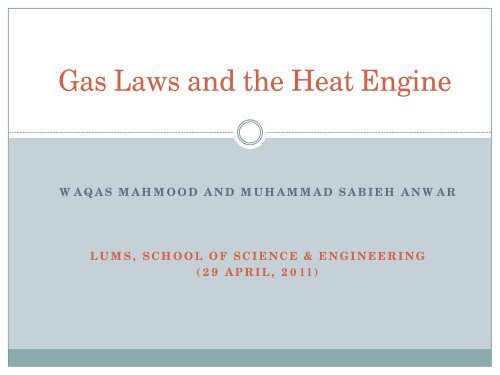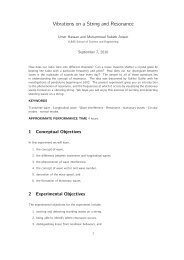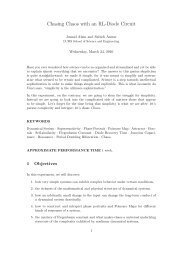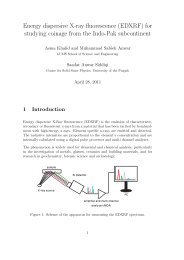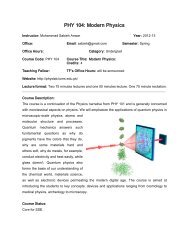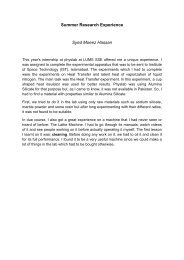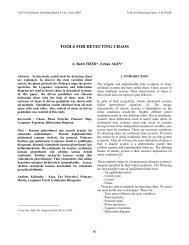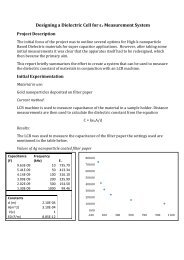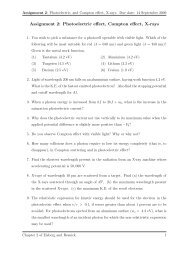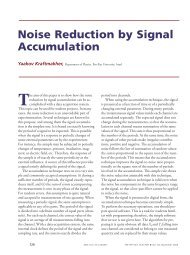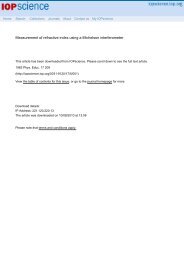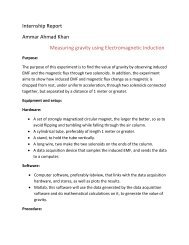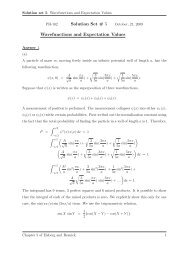Gas Laws and Heat engine - Experimental Physics
Gas Laws and Heat engine - Experimental Physics
Gas Laws and Heat engine - Experimental Physics
- No tags were found...
Create successful ePaper yourself
Turn your PDF publications into a flip-book with our unique Google optimized e-Paper software.
<strong>Gas</strong> <strong>Laws</strong> <strong>and</strong> the <strong>Heat</strong> EngineWAQAS MAHMOOD AND MUHAMMAD SABIEH ANWARLUMS, SCHOOL OF SCIENCE & ENGINEERING( 29 APRIL, 2011)
Outline• Introduction• Calibration of potentiometer• Charles’s law• Pressure versus temperature• Boyle’s law• Making a heat <strong>engine</strong>• Results• Conclusion
Introduction• This work has been described in,David P. Jackson <strong>and</strong> Priscilla W. <strong>Laws</strong>, Syringethermodynamics: The many uses of a glass syringe,American Journal of <strong>Physics</strong>, (2005).• We will be using a linear potentiometer to measurethe change in volume in our experiment. Thisexperiment has been finally included in the freshmenlab.
Placing the thermocouple inside the flask• Place the thermocouple inside the flask.• Seal it properly using Teflon tape or silicone available in our workshop.• Connect the thermocouple to multi-meter with a selection to measure temperature.
Selection of flask• We have flasks of different volumes but the choice isimportant to have reasonable expansion of the syringe.• We have used a pipette to measurethe volume of the flask (since, thegas occupies the volume of thecontainer).
Pressure sensor• MPXH6400 (Manufacturer: free scale semiconductors), the date sheetcan be downloaded from http://www.freescale.com/.
Calibration of the PotentiometerCalibration equation is, Y = 0.002 X – 7.9 e - 5
Charles’s Law :Volume vs Temperature
Absoulte zero of temperature
Pressure versus TemperatureMake sure you do not exceed the bearing pressure of flask.
Data with a curve fit
Boyle’s Law: Pressure versus VolumeEither pull or push the plunger.
Data obtained: V = Constant/P
Making a heat <strong>engine</strong>• Salman Mahmood Qazi (A student of Electronics atthe Government College University) worked on themaking of a potentiometer.• Imran Hanif worked on the electronic data takingbut he was unable to get a complete cycle.• Waqas Mahmood started working on theexperimental data taking after Imran.
• Initially balance the potentiometer for the free movement of the sliding contact.• Friction may give not required but interesting results.
Results: Trial 39
Trial 52
Calculation for the area under the curve
Calculation for Efficiencies
Gamma for air using PV = constantґ• We have obtained the value of Ґ ~ 1.0 that is in close to the published value of 1.3 by PaulF. Rebillot, Determining the Ratio Cp/Cv using Rucchart's Method, Wooster, Ohio, April(1998), http://www3.wooster.edu/physics/jris/Files/Rebillot.pdf.
Conclusion• We have achieved a mechanical efficiency > 70% <strong>and</strong> thermodynamicefficiency of < 1%.Can we improve it <strong>and</strong> how much?• Yes! We can improve slightly but not much.• If we have flasks up to 25 mL volume, the PV curve might be in a moredesired shape.• Even if you go to more smaller volumes, we can not increase thethermodynamic efficiency > 1%.• Reason: If the volume of the container is made much smaller than25mL, the air inside the flask may not be able to lift the piston.
• Although, this setup does not yield better thermodynamic efficiency butit teaches basic concepts such as pressure, heat, work done <strong>and</strong> internalenergy etc. powerfully.• It serves as a small bridge between theoretical underst<strong>and</strong>ing ofthermodynamics <strong>and</strong> experimental application at the freshmen level.Thanks


